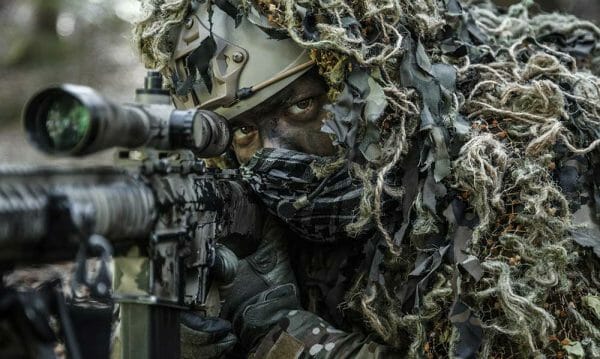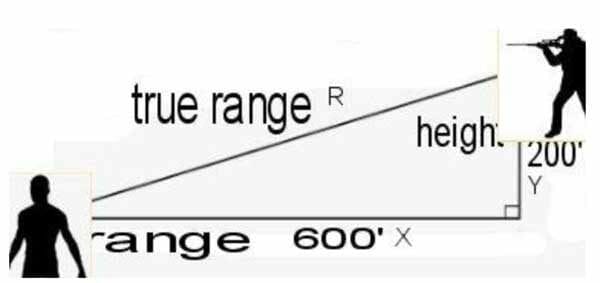Contributor John McNair offers us some education on minute of angle calculation for long distance shooting with a pretend Spy thriller twist.

USA – -(AmmoLand.com)- Let’s say you are one of the best assassins in the world and you’ve just been sent an assignment to take out a banker who had been funding a group that has been targeting retired soldiers for their role overseas. You fly to the city where it’s been suggested that it all take place and you look over what must happen.
You decide that it can be done so you accept the job… so where do you start?
It’s clear that you probably will not have more than one shot. You review the assignment and realize that there are but two possible chances from two different positions; One, at his work and the other at his home… At both places, there will be a short time as he is exiting his limo. He seldom ventures anywhere else. He is reported as being two-Hundred fifty pounds and stands six feet tall. He’s of good health and occasionally wears armor usually without a plate. He is always surrounded by bodyguards but there is a brief moment when his limo stops out front of his office and at the side of his house. You hang around and observe for a few days and verify that your information is correct. You also take time to get wind speed, atmospheric pressure readings, temperatures over the day, sun positions but most of all you watch this guy come and go.
At his office, your best position is at about six-hundred yards. It will be from a parking garage located just down the street from his office. It will be a flat shot, possible from a van parked well back into the lot. The position at his house will be from a wooded bluff about two-hundred yards away but about two-hundred feet above. The winds at the office are historically around ten mph due to building position and inner-city skyscraper effect. Each day he arrives at his office sharply at 8 AM where the sun will be at your back. He usually comes back to his house just before dark. After November 15th it will be dark after 6 PM requiring night resolution maybe IR. November 15 is the date you choose.

Why IMR 4064? Because it’s a fast, very clean-burning powder which allows the case to be filled, leaving no air space. Air space can cause small deviations in consistency depending on how the air space is oriented in the shell. Each component is weighed and matched and then each finished cartridge is weighed. The ten casings you will take have been once-fired in your rifle so that when they are reloaded only the neck is sized. You seat your bullet so that the bullet is positioned .002” the lands, the magic number for this particular rifle. After reloading you take each cartridge and lightly seal the rim and the primer. Next comes the MOA calculations.
Minute of Angle Calculations
You know your velocity average of 2859 ft/sec. So you go to the Hornady website and load the figures for the Ballistic calculations. You chose the standard calculator and name your session. Since you may be making a shot to 600 yards, you list your maximum range at 600 yards. You want your print-out to be in fifty-yard intervals using standard units. Enter the ballistic coefficient, velocity, and weight. You will zero your rifle at 100 yards and the sight height, which is the measurement from the center of the bore to the center of the scope, you enter 1.5 inches. Hit calculate for your results. You get the drop of one inch at 150 yards to 74.8-inch drop at 600 yards. The chart shows the bullet drop for every fifty yards of range. At 600 yards you’ll still have an amazing one ton of energy left to push the bullet through any Kevlar he may be wearing. It looks like you’ve chosen the right weapon and the right bullet.

Now, calculate MOA (Minute of Angle). This will give you the number of clicks on the scope to adjust your scope to compensate for bullet drop. This is very important since you will have only one shot. On most scopes, one click will give you one forth change in MOA so four clicks will equal one MOA.
You go to your secret range where you can test your calculations. After ranging your target, you interpolate the drop of the bullet based on the chart that resulted from the ballistics calculations on the Hornady website. To interpolate the data to fit your exact drop you do a ratio and proportion problem. At your practice range, you ranged a target, and the distance fell between two increments of the Hornady chart. The range was 531 yards. So you set up your ratio as X is to 531 as 46.8 is to 500. (46.8” is the drop at 500 yards.) Solve for X. You will get, X = 531 (46.8/500) which is equal to 49.7 inches.
The MOA at 531 yards is calculated by multiplying range in yards by the constant MOA at 36”. This multiplier of .010472” is found by multiplying 36” times the Tan of one-sixtieth of a degree. So 531 X .010474” will equal 5.56 inches. Now divide 49.7”(the bullet drop at 531 yards) by 5.56” which will give you 8.938 MOAs in 531 yards. There are four clicks per MOA or 4 X 8.938 which will equal 35.75 clicks or of course 36 clicks upward on the scope’s top (or vertical) turret to go from the zero point at one hundred yards for the scope to be set for 531 yards.
Lets take a minute to do a proof for the MOA multiplier, that is, the constant found at 36” so the yardage for any given distance can be multiplied by it to yield the MOA at that yardage.

Start with a right triangle with the angle between the adjacent side and the hypotenuse originating at your scope’s crosshairs. We’ll call it Theta, θ.
Y is the MOA distance in inches. X is the range in inches. Θ is equal to 1 minute expressed in degrees or 1/60° since one minute is one sixtieth of one degree. So we can express this relationship as Tan θ = Y/X. We solve for Y to find the MOA expressed in inches. Y = X Tan θ. If we find the MOA for one yard we then can multiply any yardage by that figure and get the MOA at that distance. So, Y = 36”(Tan 1/60°). Solving… we have Y = 36” X .0002908 which = .010472”. This value always stays the same and is the value which can be multiplied by any range in yards to get the MOA for that range. Example at 100 yards is 100 X .010472” = 1.0472 inches, so for 200 yards, 200 X .010472” = 2.0944 inches and so forth.
To remember this in the field, reduce your ballistic chart from Hornady to a small card and write the multiplier on the chart as well. Encase it in plastic and attach it to that particular rifle for that particular round. That should be enough to be able to calculate the MOA at any yardage in the field. Remember, it’s only good for that particular cartridge consisting of that particular bullet, powder, casing, primer, type of powder and amount of charge. Change any one element, and that would make the calculations useless.
Now, at the range where you can test your MOA calculations, you should be able to shoot accurately at 100 yards and then set your scope up for a different yardage by simply doing the calculations and resetting the vertical turret. You should be able to shoot dead-center no matter what yardage, of course depending on the wind.
Mission Go Time
You arrive a week before November 15 to look over everything, and you do some observation and ranging. You find that the exact range will be 600 yards. You also find that the wind at the office averages 10 MPH almost at 90 degrees to your bullet path from your right. Use the old military equation: Wind deflection “Z”= Wind speed ( Time to target – Range/ terminal velocity) Z= W ( t-R/V)10mph(.5247 sec-600yds/2188ft/sec) which comes out 2.36 feet which is 28.32 inches. The MOA at 600yds is 6.2832 inches so divide 28.32 in by 6.2832 in which will equal 4.51” MOA multiply that time 4 to give you the total number of clicks which is 18 clicks to the right.
You discover there is minimal air movement just before dusk at the house, but there is a considerable angle of declination to compensate for. You are two hundred yards away and two hundred feet high. What is the angle and what is the true range to the target? To find the angle use Tan = y/x solve for = Tan-1 (y/x) everything must be in feet so = Tan-1 (200’/600’)= 18.43° The angle is down, so it is -18.43°.

Now the true range can be found R2 = X2+ Y2 Where R is the true range, X is the horizontal distance to the target and Y is the elevation above the horizontal. Now solve for R= X2+Y2 substituting R= 6002+2002 = 632.5 feet
So now you’ve discovered that you may be shooting at an 18-degree declination at a total range of 632.5 feet or 632.5 divided by 3 to get a range in yards. Therefore, range = 211 yards. How will this change the calculations? MOA at 211 yards is 211 X .010472 = 2.21” Now go back to the Hornady ballistics calculator and insert the angle. At 211 yards and shooting down at -18° there is 1.23” inch drop. No turret adjustment needed.

The best shot is at his home. It has the least change in scope setting and a closer range, and it’s in a wooded area from on high. You decide to use a suppressor and determine that waiting till dark will give the greatest probability to success. You decide to use Armasight Nemesis6x-SD Gen 2+ Night Vision Rifle Scope. You realize that the MOA adjustments are in ½ moa clicks and the silencer has its added effect. So you have to recalculate everything. You need to practice your math skills anyway.
Start by rechecking everything. Yes, you could have just went there and made the shot “off-the-cuff” and been successful but you get the big bucks because you’re known for not making mistakes.
I hope you enjoyed this pretend exercise and learned something new in this MOA or Minute of Angle calculations for Assassins.
